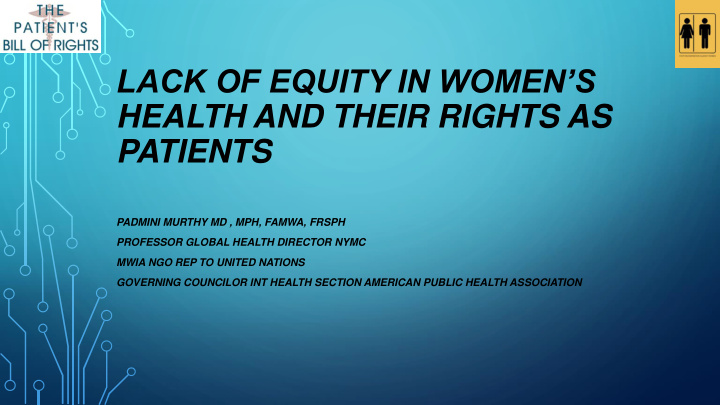



LACK OF EQUITY IN WOMEN’S HEALTH AND THEIR RIGHTS AS PATIENTS PADMINI MURTHY MD , MPH, FAMWA, FRSPH PROFESSOR GLOBAL HEALTH DIRECTOR NYMC MWIA NGO REP TO UNITED NATIONS GOVERNING COUNCILOR INT HEALTH SECTION AMERICAN PUBLIC HEALTH ASSOCIATION
INTRODUCTION • The Patient's Bill of Rights was first adopted by the American Hospital Association in 1973 and revised in October 1992. Patient rights were developed with the expectation that hospitals and health care institutions would support these rights in the interest of delivering effective patient care. • Medical law and public health law have both been used extensively as instruments of health protection and promotion but often their scope with regard to patients rights is limited. 1
THE 8 KEY AREAS OF THE PATIENT'S BILL OF RIGHTS • 1. Information for patients • 2. Choice of providers and plans • 3. Access to emergency services • 4. Taking part in treatment decisions
THE 8 KEY AREAS OF THE PATIENT'S BILL OF RIGHTS • 5.Respect and non-discrimination • 6. Confidentiality (privacy) of health information • 7. Complaints and appeals • 8. Consumer responsibilities
LINK BETWEEN HUMAN RIGHTS AND PATIENTS BILL OF RIGHTS • The concept of human rights in patient care (HRPC) is rooted in the health and human rights framework and builds on the last 2 decades of work by the health and human rights movement . 2 • It in interesting to mention that HRPC is viewed as a principled alternative to the growing discourse of “patients’ rights” that has evolved in response to widespread and severe human rights violations in health settings . 3
MEDICAL LAW AND PUBLIC HEALTH LAW • Patient care refers to the prevention, treatment, and management of illness and the preservation of physical and mental well-being through services offered by health professionals (or non- professionals under their supervision) 4 • Conversely, public health, as per the Institute of Medicine, “is what we, as a society, do collectively to assure the conditions for people to be healthy. 5
WOMEN’S RIGHTS ARE HUMAN RIGHTS • Women’s rights are human rights.” That is to say, women are entitled to all of these rights. Yet almost everywhere around the world, women and girls are still denied them, often simply because of their gender.
BRIEF SYNOPSIS OF WOMEN’S HUMAN RIGHTS • “ The women’s human rights movement evolved, in part, because of limitations in the UN human rights system – a system that dated back to 1945 and focused primarily on curtailing powers of the State. The emphasis at the time was on civil and political rights rather than social, economic and cultural rights, which are central to women’s everyday lives. • Such gaps became evident in the ‘development decades’ of the 1960s and 1970s. During this time, for example, positive advances were made in agriculture and food production. However, they failed to acknowledge that, in most parts of the world, women were the primary producers of food. • New technologies were developed, but women were often excluded from access and training. Furthermore, land reforms were initiated, but failed to recognize that women were often restricted from owning land. As a result, women were displaced from many of their traditional roles and disempowered. Later development efforts emphasized employment and income-generation for women and recognized the importance of the information. “ 6
CEDAW AND ITS LINK TO PATIENTS RIGHTS • Accountability. Duty bearers (primarily the State, but also parents, teachers and others) need to be held accountable for their obligations and responsibilities. Systems of accountability may include legal redress, but can also be promoted more broadly by fostering transparency and a free media. • Universality. All people, by virtue of being human, are holders of human rights. • Indivisibility. All rights have equal status and are interdependent. The promotion of one right does not justify violation of another right. 6
CEDAW AND ITS LINK TO PATIENTS RIGHTS • Non-discrimination. All individuals are entitled to human rights without discrimination of any kind on the basis of race, colour, sex, ethnicity, age, language, religion, political or other opinion, national or social origin, disability, property, birth or other status. • Participation. All individuals are entitled to active, free and meaningful participation in the fulfilment of their rights 6
EXAMPLES OF DISCRIMINATION AGAINST WOMEN
EXAMPLES OF DISCRIMINATION AGAINST WOMEN
EXAMPLES OF DISCRIMINATION AGAINST WOMEN
EXAMPLES OF DISCRIMINATION AGAINST WOMEN
ACTIVISM
CONCLUSION
REFERENCES • 1 . Patient’s bill of rights Retrieved from https://www.healthsourceglobal.com/docs/Patient%20Bill%20of%20Rights_merged.pdf • 2. Mann JM. Health and human rights — if not now, when? Health and Human Rights. 1997;2(3):113 – 20. • 3. Cohen J, Ezer T. Human rights in patient care: a theoretical and practical framework. Health and human rights. 2013;15(2):7 – 19 • 4. Dorland’s illustrated medical dictionary, 28th. 1994. Google Scholar • 5.The Institute of Medicine report on the future of public health. 1988:19.Google Scholar • 6.UNFPA Wom4ns and Children’s Rights Making The connection https://www.unfpa.org/sites/default/files/pub -pdf/Women- Children_final.pdf
Recommend
More recommend